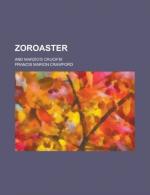“Marzio!”
The artist had quickly brought his hand to his forehead, and the ghastly affectation of a smile wreathed about his white lips. His voice was thick.
“I was only shading my eyes from the sun. Don’t you see how it dazzles me, reflected from the silver? What did you imagine, Paolo? You look frightened.”
“Oh, nothing,” answered the priest bravely. “Perhaps I am a little nervous to-day.”
“Bacchus! It looks like it,” said Marzio, with an attempt to laugh. Then he tossed the tool upon the table among the rest with an impatient gesture. “What do you think of the crucifix?”
“It is very wonderful,” said Paolo, controlling himself by an effort. “When did you make it, Marzio? You have not had time—”
“I made it years ago,” answered the chiseller, turning his face away to hide his pallor. “I made it for myself. I never meant to show it, but I believe I cannot do anything better. Will it do for your cardinal? Look at the work. It is as fine as anything of the kind in the world, though I say it. Yes—it is cast. Of course, you do not understand the art, Paolo, but I will explain it all to you in a few minutes—”
Marzio talked very fast, almost incoherently, and he was evidently struggling with an emotion. Paolo, standing back a little from the bench, nodded his head from time to time.
“It is all very simple,” continued the artist, as though he dared not pause for breath. “You see one sometimes makes little figures of real repousse, half and half, done in cement and then soldered together so that they look like one piece, but it is impossible to do them well unless you have dies to press the plate into the first shape—and the die always makes the same figure, though you can vary the face and twist the arms and legs about. Cheap silver crucifixes and angels and those things are all made in that way, and with care a great deal can be done, of course, to give them an artistic look.”
“Of course,” assented Don Paolo, in a low voice. He thought he understood the cause of his brother’s eloquence.
“Yes, of course,” continued Marzio, as rapidly as before. “But to make a really good thing like this, is a different matter. A very different matter. Here you must model your figure in wax, and make moulds of the parts of it, and chisel each part separately, copying the model. And then you must join all the parts together with silver-soldering, and go over the lines carefully. It needs the most delicate handling, for although the casting is very heavy it is not like working on a chalice that is filled with cement and all arranged for you, that can be put in the fire, melted out, softened, cooled, and worked over as often as you please. There is no putting in the fire here—not more than once after you have joined the pieces. Do you understand me? Why do you look at me in that way, Paolo? You look as though you did not follow me.”




